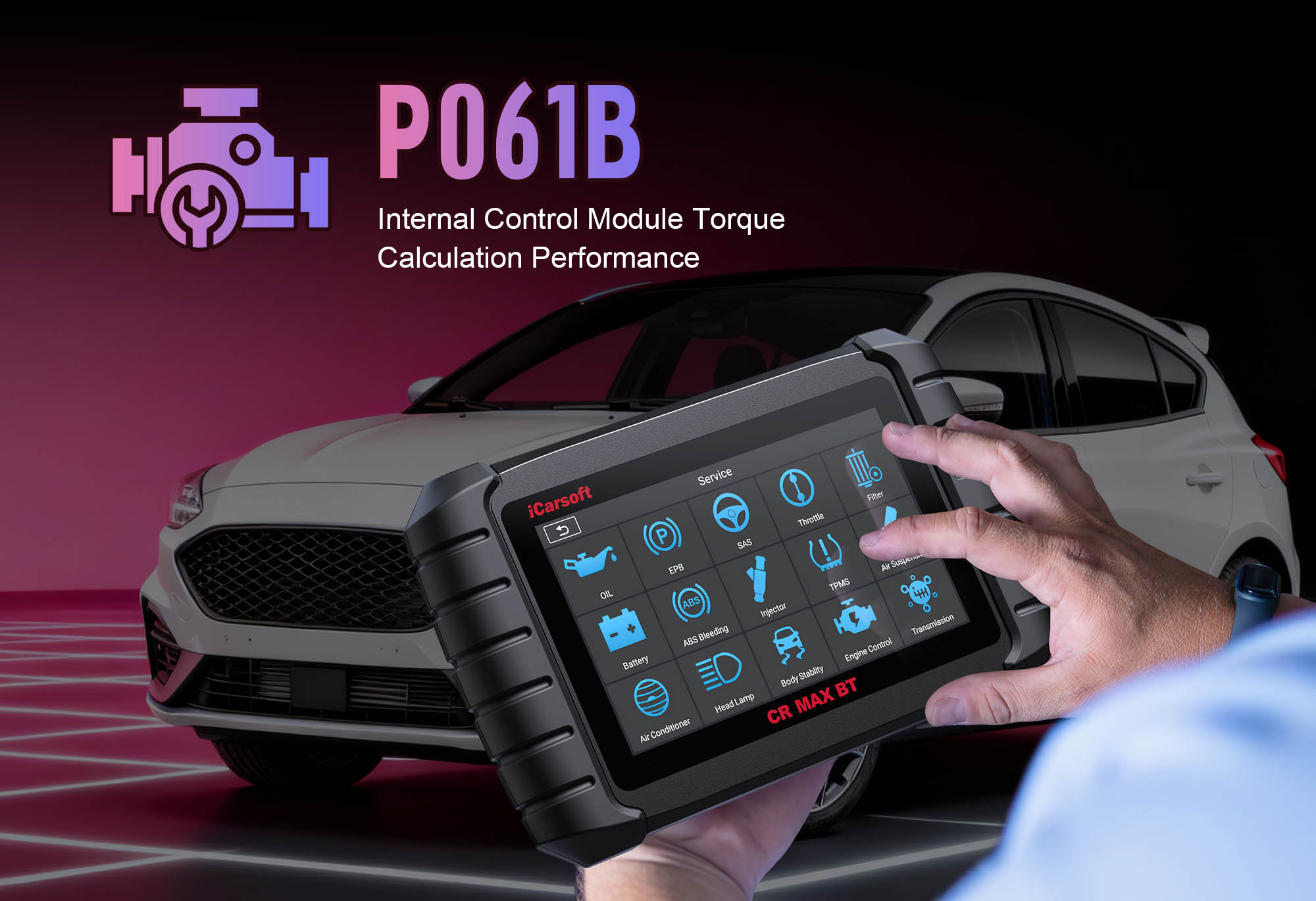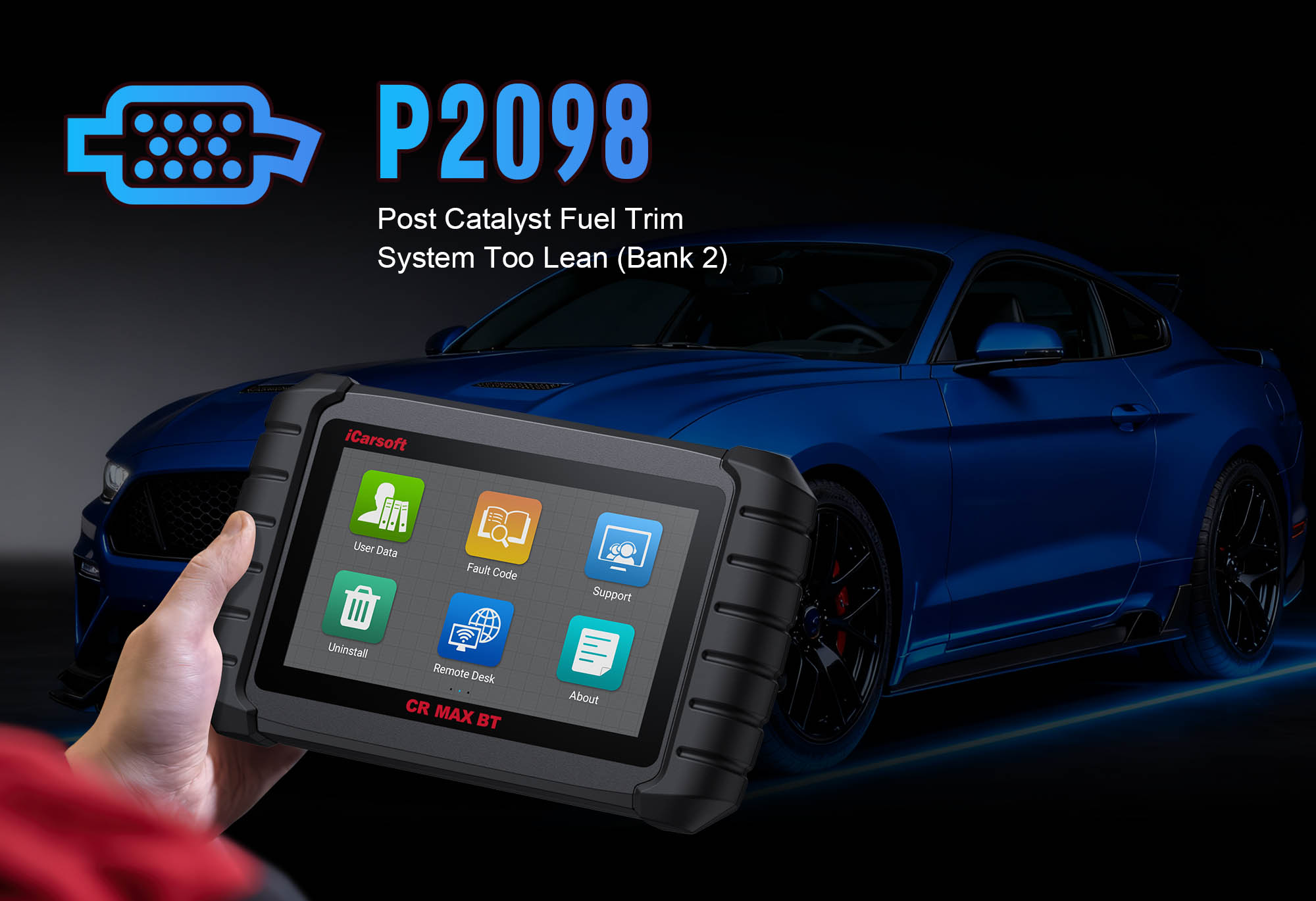Diagnose & Clear P061B with iCarsoft CR MAX BT: Fix Internal Control Module Torque Calculation Performance
Diagnose & Clear P061B with iCarsoft CR MAX BT
If your vehicle’s check engine light illuminates, you notice reduced acceleration, or it enters limp mode during heavy load (e.g., towing), a diagnostic scan will likely return P061B. This OBD-II code stands for "Internal Control Module Torque Calculation Performance"—a fault targeting the Engine Control Module (ECM) or Transmission Control Module (TCM) and its torque calculation ability.
The ECM/TCM uses sensor data (throttle position, crankshaft position) to adjust fuel injection, ignition timing, and shifts for optimal torque. When calculations fall outside acceptable ranges, the module limits performance to protect the drivetrain, leading to sluggishness, poor efficiency, and potential damage. Basic scanners only flag "control module issues," but the iCarsoft CR MAX BT solves this. Let’s break down how to resolve P061B step by step.
Understanding P061B: Causes & Key Symptoms
Torque calculation ensures the engine delivers power without straining components. P061B triggers when there’s a mismatch between "requested torque" (driver input) and "actual torque" (sensor-measured). As the fault persists, symptoms disrupt driving.
Key Symptoms of P061B
-
Check Engine Light (CEL): A steady CEL illuminates, and some vehicles display "Torque Management Fault" or "Control Module Performance" warnings.
-
Reduced Power/Limp Mode: The module caps speed at 40–50 mph to prevent damage, making acceleration sluggish.
-
Erratic Shifting (Automatics): The TCM delays shifts, shifts harshly, or stays in one gear to avoid torque stress.
-
Poor Fuel Economy: Incorrect calculations disrupt air-fuel ratios, dropping mileage by 15–20%.
-
Misfires/Stalling: Severe miscalculations cause incomplete combustion, leading to idle misfires or acceleration stalling.
Common Causes of P061B
|
Cause
|
Description
|
|
Faulty Sensors
|
Malfunctioning TPS, MAF, CKP, or IAT sensors provide inaccurate data for torque calculations (most common cause).
|
|
Damaged Wiring/Harnesses
|
Frayed wires, corrosion, or rodent chew marks in sensor circuits distort signals, leading to incorrect torque estimates.
|
|
ECM/TCM Software Issues
|
Outdated or corrupted firmware fails to process sensor data correctly, miscalculating torque.
|
|
Mechanical Drivetrain Issues
|
Worn clutch (manuals), slipping torque converter (automatics), or restricted exhaust reduce actual torque, creating a mismatch.
|
|
ECM/TCM Hardware Failure
|
Rarely, internal components (microchips, capacitors) fail, preventing accurate torque calculation.
|
Why iCarsoft CR MAX BT Excels at Diagnosing P061B
The CR MAX BT outperforms basic tools with features tailored to control module and torque diagnostics—critical for resolving P061B accurately:
Live Torque Data Tracking
Monitors "Requested Torque" vs. "Actual Torque" and sensor values (TPS, MAF), instantly flagging mismatches or out-of-range readings.
ECM/TCM Communication Tests
Verifies if the module receives/processes sensor data correctly—distinguishes module faults from sensor/wiring issues.
Bi-Directional Sensor Tests
Sends commands to activate sensors (TPS, MAF) and verify responsiveness—rules out stuck or uncalibrated components.
Firmware Update Checks
Alerts to outdated ECM/TCM software (top cause of P061B) and guides to compatible updates via "One-Key Upgrade."
Wireless Bluetooth Connectivity
Tests ECM/TCM and sensors from 30 feet away—no cords hinder access to under-hood/under-dash components.
Step-by-Step: Diagnose P061B with iCarsoft CR MAX BT
-
Safety First & Initial Visual Inspection
1. Avoid heavy loads: Don’t tow or drive at high speeds until the fault is fixed to prevent drivetrain stress.
2. Inspect key sensors: Locate TPS (throttle body), MAF (air intake), CKP (crankshaft pulley)—check for contamination/loose bolts.
3. Check wiring: Follow sensor harnesses to ECM/TCM—look for frays, chew marks, or corrosion; repair with heat-shrink.
4. Inspect mechanics: For manuals, check clutch pedal free play; for automatics, listen for torque converter whirring.
-
Connect the Tool & Confirm P061B
Plug CR MAX BT into OBD-II port, power on, select AutoVIN Identify to retrieve specs. Navigate to Engine > Fault Codes > Read Codes to confirm P061B. Tap Code Details for insights (e.g., "Chevrolet: Requested 250 lb-ft, Actual 180 lb-ft; Check TPS/MAF") and check related codes (P0121, P0101).
-
Monitor Live Torque & Sensor Data
1. Start engine, idle 5 minutes to stabilize.
2. Navigate to Engine > Live Data > Torque Management—monitor metrics:
- Torque match: Actual should be within 10–15% of requested; consistent gaps confirm P061B.
- Sensor values: TPS (0.5V closed–4.5V open), MAF (2–5 g/s idle), CKP (matches RPM)—erratic values = sensor fault.
3. Load test: Accelerate to 30 mph—widening gaps = mechanical issue (e.g., slipping torque converter).
-
Test Sensors & Module Communication
1. Sensor tests:
- TPS Relearn: Special Functions > Engine > Electronic Throttle Control > TPS Relearn—follows prompts to recalibrate.
- MAF Activation: Bi-Directional Tests > MAF Sensor Activation—no airflow change = faulty MAF.
- CKP Waveform: Advanced Diagnostics > Oscilloscope—irregular waves = CKP/wiring fault.
2. Module communication: ECU Information > ECM/TCM Status—"Offline" = wiring/module failure; run Control Module Reset to fix glitches.
-
Address Mechanical & Software Issues
1. Mechanical repairs:
- Clutch/torque converter: Replace slipping clutches; inspect converters via Transmission Control Service.
- Exhaust restrictions: Use EGR Service to check for clogged EGR/catalytic converters.
2. Software updates: Check One-Key Upgrade for ECM/TCM firmware—install updates to fix calculation bugs.
-
Repair & Clear P061B
- Faulty sensors: Replace with OEM parts (e.g., Bosch 0280122025 for MAF); relearn via CR MAX BT.
- Wiring: Repair frays or replace harnesses; clean connectors with contact cleaner.
- Mechanics: Replace clutches, converters, or clogged exhaust components.
- Software/hardware: Install firmware updates; consult dealer for module replacement if faulty.
Clear code: Engine > Fault Codes > Clear Codes—confirm P061B is deleted.
-
Validate the Repair
1. Post-repair data: Confirm torque match (within 10%) and stable sensor values.
2. Test drive 40–50 minutes: Include light acceleration, heavy loads, and highway driving—no limp mode/hesitation.
3. Run I/M Readiness Test: OBDII Functions—verify ECM/TCM monitor is "Ready" for emissions compliance.
4. Save report: History & Report—document fault, repairs, and post-repair data.
Preventing P061B Recurrence
-
Regular Sensor Checks: Use Service Reminder to test TPS, MAF, CKP every 30,000 miles—catch early wear.
-
Software Maintenance: Enable Update Notifications for ECM/TCM firmware—install updates promptly.
-
Drivetrain Care: Follow Maintenance Schedule—replace air filters (prevents MAF clogging), change transmission fluid, inspect clutches every 60,000 miles.
-
Lifetime Free Updates: Use One-Key Upgrade to add new torque management diagnostic features.
Conclusion
P061B’s torque calculation fault risks drivetrain damage from unregulated stress. The iCarsoft CR MAX BT simplifies diagnosis with live tracking, sensor tests, and communication checks—ensuring you fix the root cause (sensor, wiring, or module) instead of guessing.
With global coverage, 40+ service functions, and lifetime updates, the CR MAX BT is a long-term investment in torque control reliability. Restore acceleration, eliminate limp mode, and drive with confidence—all with one professional-grade tool.





